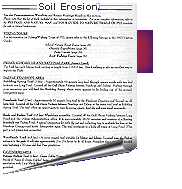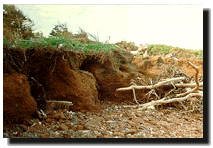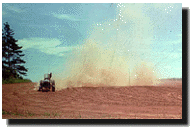

Gently rolling fields in infinite shades
of green, sandy white beaches, and red sandstone cliffs
are the landscapes most identified with Prince Edward
Island. Besides their astounding natural beauty, these
landforms share another characteristic: they are
disappearing due to erosion. Soil erosion is a process
whereby particles of soil become detached from the
surface of the land and are swept away by wind or water.
Wind erosion occurs when the soil is dry. This is one
reason why sand dunes on Island beaches are shifting or disappearing. Dune erosion is
accelerated by pedestrian and  vehicular traffic travelling across the
dunes and the trampling of the fragile marram grass that
supports the dune system. Strong winds, severe wave
action and high tides under storm conditions also take a
toll on our sandstone cliffs.These winds undermine the
cliff base at shore level until the hanging ledge sinks
onto the beach for lack of support, dragging sod and
trees and shrubs along with it.
vehicular traffic travelling across the
dunes and the trampling of the fragile marram grass that
supports the dune system. Strong winds, severe wave
action and high tides under storm conditions also take a
toll on our sandstone cliffs.These winds undermine the
cliff base at shore level until the hanging ledge sinks
onto the beach for lack of support, dragging sod and
trees and shrubs along with it.
Since the early 1800s, farming has been a vital part of
living on the Island. Today, agriculture continues to be
Prince Edward Island’s most important
industry—we depend on our rich sandy loam for our
individual sustenance as well as for our collective
economic well-being. However, demands for increasing
agricultural productivity are depleting the soil and the
long-term sustainability of agriculture while also
jeopardizing the health of the Island environment. On
farms, erosion results in loss of topsoil, reduction of
soil fertility and organic matter levels, increased need
for fertilizers and pesticides, poor drainage, creation
of gullies in fields, and reduced long term farm
viability.
Soil erosion is influenced by many factors besides
agricultural practice. These factors include climate,
topography, and even the history of land tenure on the
Island. Prince Edward Island is subject to freeze-thaw
cycles that place soil at high erosion risk. Occasional
but rapid and drastic temperature fluctuations in January
and February (rising as much as 25oC) can
cause top layers of soil to thaw and wash away. Rapid
snow melt in spring can lead to similarly heavy erosion.
Heavy summer storms or high winds can cause soil loss
during the growing season.
Ironically, the Island’s peacefully rolling
landscape is a major factor in soil erosion. Short steep
slopes obviously have gravity working against them, but
even long low slopes allow a high volume of water to
accumulate. Both types of slopes witness vast amounts of
soil washed away annually. Historically, farms on Prince
Edward Island—and in colonial New France—were
built along shorelines or along roads, benefiting from a
small frontage with acreage extending far behind. With
farms divided into long and narrow lots, cross-slope
cultivation,  strip cropping and
terracing are difficult to implement on individual farms.
While many of these factors cannot be controlled,
cultivation and cropping techniques can reduce the rate
of soil loss.
strip cropping and
terracing are difficult to implement on individual farms.
While many of these factors cannot be controlled,
cultivation and cropping techniques can reduce the rate
of soil loss.
Besides causing the loss of valuable and irreplaceable
topsoil, erosion creates problems for Island
watercourses. Erosion in the form of surface runoff
contaminates our waterways with pesticides, nutrients,
and bacteria. Runoff clogs drainage ditches and culverts,
harms fish and wildlife, buries shellfish beds, reduces
coastal water depth, overloads aquatic environments with
nutrients, and pollutes aquatic environments with toxic
pesticides. While farming activity is a key cause of
siltation, road construction, unpaved roads, building
construction, and subdivision construction cause many of
the localized siltation problems in Island ditches and
waterways.
Soil
Conservation | Ground Water
Quality | Surface Water
Quality |
Forestry Practices | Natural Disasters | Irving Whale